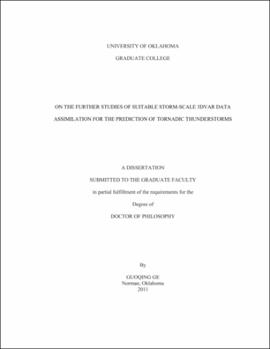| dc.contributor.advisor | Droegemeier, Kelvin||Gao, Jidong | |
| dc.creator | Ge, Guoqing | |
| dc.date.accessioned | 2019-04-27T21:37:17Z | |
| dc.date.available | 2019-04-27T21:37:17Z | |
| dc.date.issued | 2011 | |
| dc.identifier | 99346905002042 | |
| dc.identifier.uri | https://hdl.handle.net/11244/319176 | |
| dc.description.abstract | Storm-scale 3DVAR data assimilation and NWP for the prediction of tornadic supercell thunderstorms still faces many challenges. Some fundamental issues are still not thoroughly (or explicitly) investigated. To name a few: what data field(s) plays the most important role in storm-scale data assimilation? How much information is required to get a quality data assimilation results? What is the model's first response to different types of observations? How will the neglecting of beam broadening and earth curvature factors in radar forward observation operator affect the data assimilation results? How to build a more dynamic consistent analysis by imposing weak constraints in cost function that is aimed to couple different model variables? This dissertation tries to address some of these questions. | |
| dc.description.abstract | The impacts of different data fields are firstly investigated. OSS Experiments are conducted under a simplified 3DVAR framework. The model's first responses at storm scale to the assimilation of different types of observations are thoroughly examined. It is also demonstrated that the horizontal wind fields have the greatest impact on the storm-scale data assimilation. In addition to the horizontal wind fields, extra observations from other model variables will improve the quality of data assimilation. Among these "other model variables", the water vapor field exerts the largest impact. A follow-on real case study confirms the important role of wind fields. | |
| dc.description.abstract | The impact of beam broadening or earth curvature on storm-scale 3DVAR data assimilation is also examined using OSS experiments. It is shown that the effect of beam broadening can be generally overlooked in storm-scale radar data assimilation without noticeable degradation of assimilation results. However, the effect of earth curvature can only be neglected when the radar is near the storm (within 60 km as demonstrated by this study). The impact of refractive index gradient is also tested and shown to be small. | |
| dc.description.abstract | To help boost dynamic consistency among model variables, the storm-scale diagnostic pressure equation is incorporated into the storm-scale 3DVAR cost function in the form of a weak constraint. The impact of the constraint has been examined by applying it to case studies of one idealized tornadic supercell thunderstorm and two real-world tornadic supercell thunderstorms. It is demonstrated in the idealized case study that at single analysis step, the use of the constraint can help slightly improve the analysis of wind fields and pressure field. After a given period of intermittent data assimilation, the use of the constraint can evidently improve the quality of the data assimilation results. For the 8 May 2003 OKC tornadic supercell thunderstorm case, it is shown that the use of the constraint help improve the forecast in term of the general evolution and the mesocyclone rotation of the major tornadic supercell thunderstorm. For the 5 May 2007 Greensburg tornadic supercell thunderstorm case, two different assimilation configurations are introduced to examine the impact of the constraint under different situations. It is shown that assimilating wind data alone produces reasonable forecast and the use of the diagnostic pressure equation constraint evidently improve the forecast. When assimilating reflectivity data in addition to wind data, the impact of the constraint is also positive. Overall, it is demonstrated that the constraint can improve the quality of radar data assimilation and the subsequent forecast. | |
| dc.format.extent | 215 pages | |
| dc.format.medium | application.pdf | |
| dc.language | en_US | |
| dc.relation.requires | Adobe Acrobat Reader | |
| dc.subject | Thunderstorm forecasting | |
| dc.subject | Weather forecasting | |
| dc.subject | Tornadoes | |
| dc.subject | Doppler radar | |
| dc.title | ON THE FURTHER STUDIES OF SUITABLE STORM-SCALE 3DVAR DATA ASSIMILATION FOR THE PREDICTION OF TORNADIC THUNDERSTORMS | |
| dc.type | text | |
| dc.type | document | |
| dc.thesis.degree | Ph.D. | |
| ou.group | College of Atmospheric & Geographic Sciences::School of Meteorology | |
